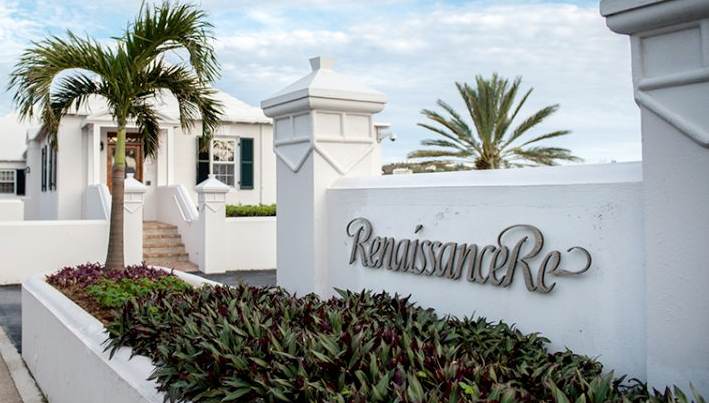RenaissanceRe has reported significant growth in the second-quarter of 2019, with its gross premiums underwritten rising by 51% while its investment return helped it to near double net income to almost $368 million for the period.
 The Bermuda headquartered reinsurance firm took advantage of strong price rises across many areas of its business to deploy more capital in the second-quarter of the year, increasing its gross written premiums by $499.6 million, or 51.1%, to $1.5 billion.
The Bermuda headquartered reinsurance firm took advantage of strong price rises across many areas of its business to deploy more capital in the second-quarter of the year, increasing its gross written premiums by $499.6 million, or 51.1%, to $1.5 billion.
RenRe’s property underwriting segment drove $286.6 million of the increase, while the casualty and specialty lines business at the company drove another $213.0 million of increased premium growth.
Net income of $367.9 million, or $8.35 per diluted common share, in the second quarter of 2019, compared to $191.8 million, or $4.78 per diluted common share in the prior year, a more than 90% increase.
Operating income did not show the same rise, offset by a number of factors, at $212.6 million, or $4.78 per diluted common share, in the second quarter of 2019, compared to $204.3 million, or $5.10 per diluted common share in the prior year.
Demonstrating the return potential of its business, RenRe reported an annualised return on equity of 28.9%, up from 18.6% in the prior year.
But the operating return on equity was lower at 16.7% in the second quarter of 2019, down from 19.8% in the prior year.
Commenting on the quarters results, Kevin J. O’Donnell, President and Chief Executive Officer of RenaissanceRe, said, “I am pleased with our performance in the second quarter, where we achieved annualized operating return on average common equity of 16.7% and growth in tangible book value per common share plus accumulated dividends of 8.2%. This strong performance was due to the diligent execution of our differentiated strategy, resulting in solid profits, material growth and improved operational efficiency. The portfolio of risks we have constructed is larger, more diverse and increasingly efficient, and poised to drive superior long-term returns for our shareholders.”
Part of the reason operating earnings and RoE have not increased as much were accident year catastrophe impacts, some loss creep characterised in lower than expected reserve releases, higher than analysts forecast expenses, and the distribution of more capital to shareholders and third-party capital partners in the period, it seems.
But strong underwriting growth should be set to drive ongoing profitability for RenRe through the coming quarters as long as fresh catastrophe activity remains light, having bulked up at the higher pricing that has been available at renewals so far this year.
Underwriting income was actually lower, at $170.8 million in Q2 2019 with a combined ratio of 81.3%, compared to $226.6 million and 47.2% in the prior year period.
The company said the dip in underwriting income was due to the fact the prior year quarter had significant reserve releases from 2017 loss events, which wasn’t repeated here.
You could of course also interpret this as there being less to release because the reserves set for 2018 accident year losses have likely developed upwards to a degree, making less favourable development available to release in 2019. However, this still suggests prudent reserving by RenRe on those events that are driving negative reserve impacts elsewhere in the market.
A significant amount of the earnings beat is attributable to the investment result at RenRe, with the firm reporting $309.8 million of gains in the second quarter of 2019, and an annualised total investment return of 8.0%.
The investment result in the prior year period was just $53.5 million, so significantly lower than has been achieved in 2019 and in fact the investment result for the first six months of the year is now at $561.9 million, much higher than the $27.8 million of investment returns achieved in H1 of 2018.
Also of note during the quarter, RenRe reported raising over $700 million in new third-party capital inflows for its joint-venture and insurance-linked securities (ILS) vehicles, a significant amount and a sign of the more attractive reinsurance renewal conditions at the mid-year in 2019.
In the property segment at RenRe, underwriting income came out at $151.7 million with a combined ratio of 64.3% in Q2 2019, compared to $213.7 million and negative -4.7% in the prior year.
While the property underwriting result in Q2 2019 benefited from lower current accident year net claims and claim expenses thanks to a relatively lower level of insured catastrophe events, these were partially offset by adverse development on prior accident years losses as well as higher than expected losses in the other property class of business.
Underwriting income for the casualty and specialty segment came out at $19 million with a combined ratio of 96.1% in Q2 2019, compared to $13.0 million and 94.2% in the prior year.
So the results are mixed for RenRe, but no surprise that the underwriting result dipped after the significant releases achieved in the prior year Q2.
The investment return has delivered a strong quarter of income that should please shareholders, while third-party capital partners should be pleased by the increased size of the underwriting portfolio and the promise that returns will be rising with higher rates in quarters to come.


